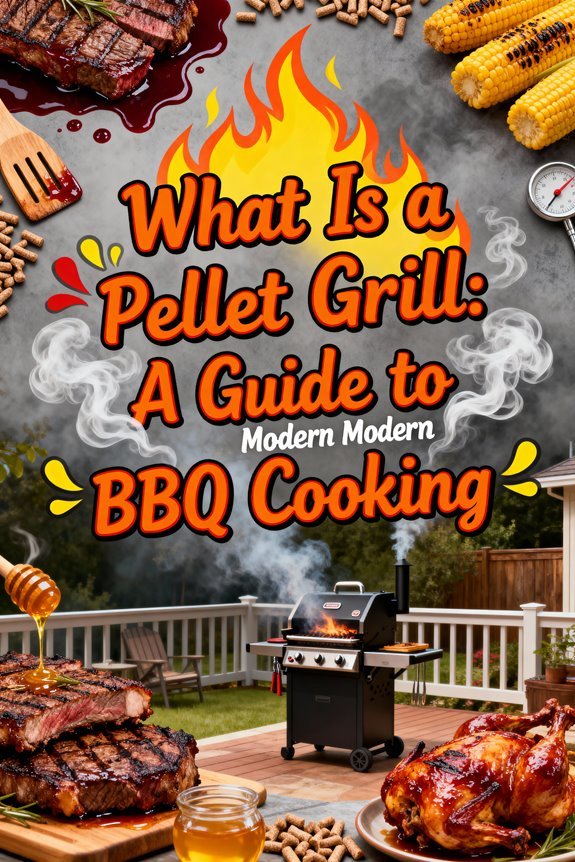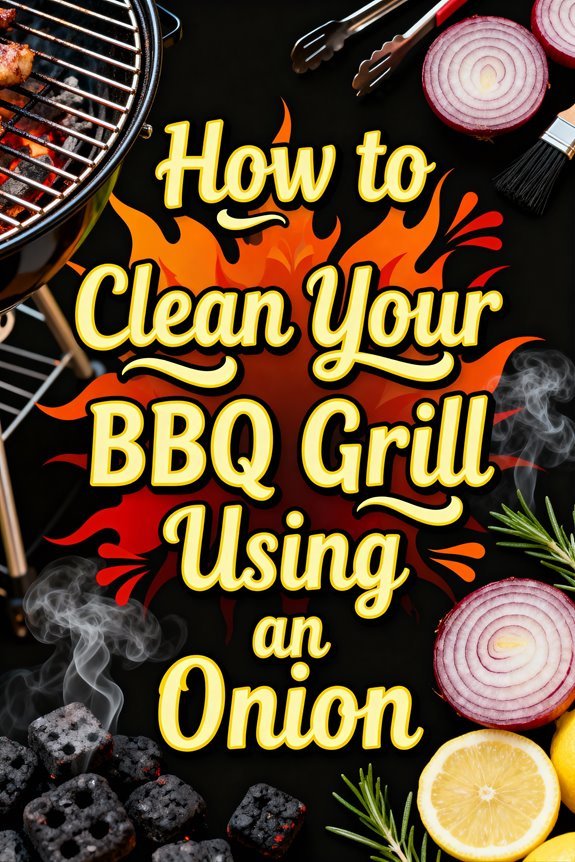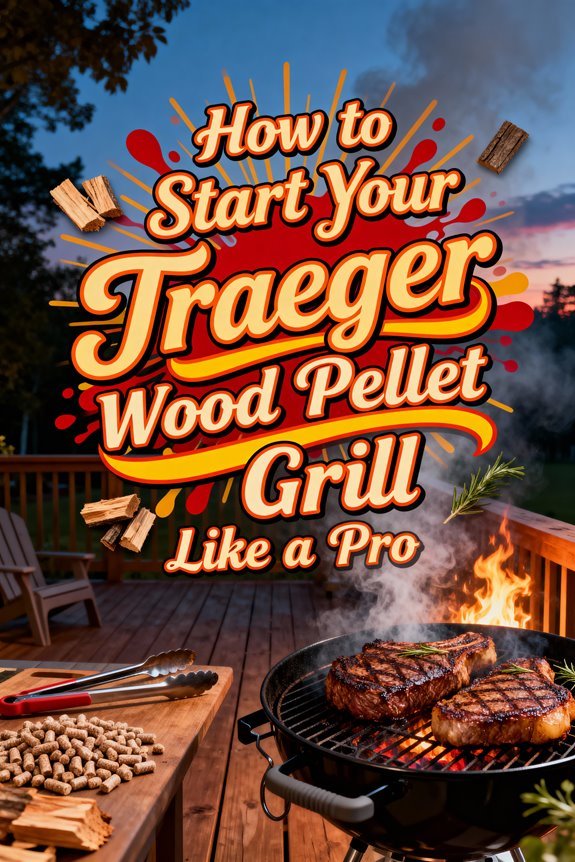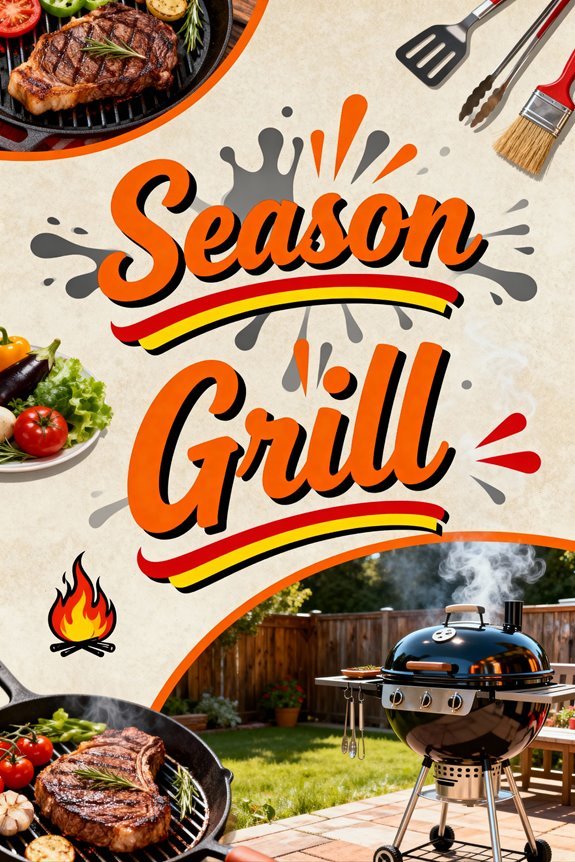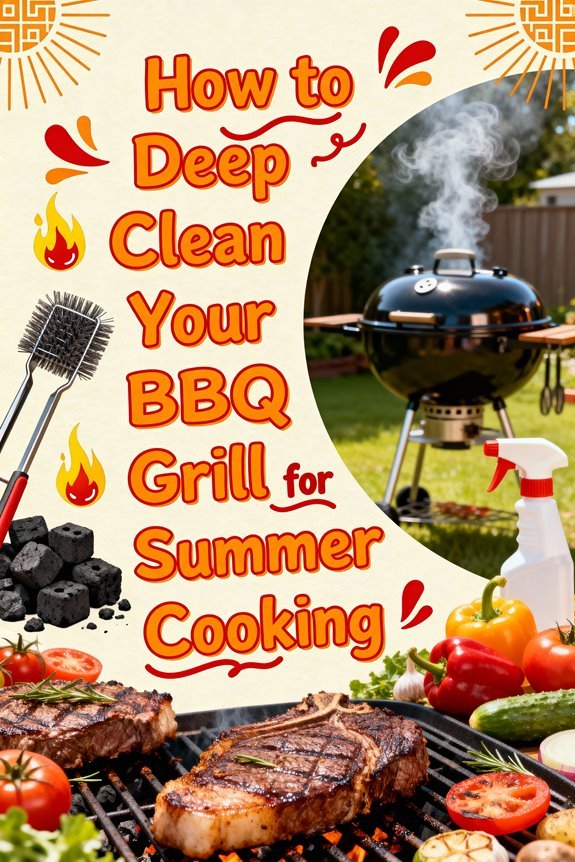A pellet grill uses compressed hardwood pellets and automated digital controls to give you wood-fired flavor without constant temperature babysitting. You’ll get cooking temperatures from 180°F to 500°F—perfect for low-and-slow brisket or high-heat searing. An auger feeds pellets into the firebox while fans circulate heat evenly throughout the chamber. The digital controller monitors your cook in real-time, adjusting pellet flow to maintain precise temperatures within just a few degrees. This guide breaks down exactly how these components work together to transform your outdoor cooking.
Understanding How Pellet Grills Work
Pellet grills combine traditional wood-fired cooking with modern automation to deliver consistent results across multiple cooking methods. At startup, compressed hardwood pellets drop from the hopper into the firebox, where a hot rod handles pellet ignition. Once the fire establishes, internal fans circulate air to maintain combustion and distribute heat throughout the cooking chamber. Similar to how cast iron searing creates a perfect crust on steaks, pellet grills can achieve high-temperature cooking results.
The real innovation lies in temperature regulation. A digital controller monitors your set temperature and adjusts the auger’s pellet feed rate accordingly. This automated system maintains temperatures from 150°F for low-and-slow smoking up to 500°F for searing, eliminating the constant adjustments you’d make with charcoal or gas grills. Low and slow cooking at 225°F to 275°F is ideal for smoking delicate meats like turkey breast.
The auger continuously feeds pellets based on your cooking needs, while safety features like positive pressure fans prevent dangerous burn-back scenarios. These pellets are manufactured from wood waste sawdust without any binders or glue, making them a pure fuel source for your grill.
[affiai keyword=”digital temperature control pellet grill” template=”carousel” count=”3″
The Evolution of Pellet Grill Technology
While wood pellet heating technology emerged from the 1970s energy crisis as a practical alternative fuel solution, it took another decade before Joe Traeger recognized its potential for outdoor cooking. In 1985, Traeger created the first commercially viable pellet grill prototype, marking one of the most significant historical milestones in barbecue innovation. His design integrated an electric auger system that automated pellet feeding—a vital technological advancement that enabled precise temperature control. After patenting the design in 1986, the technology evolved steadily through the following decades. The 2000s brought digital controls and improved combustion chambers, making pellet grills more accessible. Today’s models feature Wi-Fi connectivity, multi-zone cooking capabilities, and enhanced insulation, transforming what began as an energy-efficient heating concept into sophisticated outdoor cooking equipment. Manufacturers now prioritize improved efficiency and lower emissions as consumers become increasingly environmentally conscious. Modern pellet grills utilize fire pot ignition systems that work alongside fans to distribute heat and smoke evenly throughout the cooking chamber. These versatile units can maintain temperatures from 180-500 degrees for everything from slow smoking to high-heat grilling.
Key Components That Power Your Pellet Grill
Understanding how pellet grills function requires examining the engineered systems that work in concert to transform compressed wood into consistent heat and smoke. The auger system serves as the mechanical backbone—its motor-driven spiral conveyor transports pellets from hopper to fire pot while feed controls regulate flow rates for temperature precision. When jams occur, the fail-safe reverses rotation to clear obstructions. Prime function activation helps ensure proper pellet delivery during initial startup sequence.
Ignition components initiate combustion through hot rod igniters that reach temperatures sufficient to ignite wood pellets within minutes. Advanced silicon nitride kits reduce heating time further. The thermocouple measures real-time temperatures, feeding data to the smart combustion motherboard that adjusts pellet delivery accordingly. The digital controller system maintains precise temperature control throughout the cooking process.
Airflow management relies on induction and combustion fans working synchronously. They maintain oxygen levels necessary for complete combustion while directing smoke through the chimney, ensuring consistent heat distribution across your cooking surface. The convection fan ensures even cooking temperature throughout the chamber, which is essential for achieving professional-quality results.
Cooking Methods and Temperature Capabilities
Mastering the mechanical systems inside your pellet grill means little if you can’t leverage them across different cooking applications. Your grill’s temperature control spans 180°F to 500°F, enabling everything from low-and-slow smoking to high-heat grilling. Maximum smoke production occurs between 225–275°F—perfect for brisket and pork shoulder during the critical first 3–4 hours of cooking. Above 300°F, visible smoke diminishes, but wood flavor persists. For tender brisket results, plan on smoking time of 1.5-2 hours per pound at 225°F.
You’re not limited to smoking. Reverse searing delivers restaurant-quality steaks, while precise heat distribution supports baking bread and roasting vegetables. The fan-driven convection system creates an even cooking environment for delicate proteins on upper racks. For enhanced searing, use cast-iron skillets or models with dedicated sear zones. The medium-high heat range of 300-450°F is ideal for grilling vegetables like eggplant to achieve perfect tenderness. Water pans stabilize temperature during extended indirect cooks. Premium hardwood pellets produce superior smoke flavor and cleaner combustion compared to lower-quality alternatives that contain fillers or additives.
Fuel Efficiency and Cleaning Requirements
Every pellet you burn translates directly to operational cost and cook time between refills. Your fuel consumption varies dramatically: expect 1–1.5 lbs per hour at smoking temperatures (225–275°F) versus 3–4 lbs per hour at high heat (450–600°F). A standard 20 lb bag delivers 15–20 hours of low-temp smoking or just 6 hours of searing.
Maintenance directly impacts efficiency. Ash buildup restricts airflow, forcing your grill to burn more pellets for inconsistent temperatures. Vacuum your firepot after every few cooks and clean grease trays regularly. For safe grill cleaning, using aluminum foil balls provides an effective way to scrub grates without risking metal bristle contamination. These maintenance tips aren’t optional—neglect causes temperature swings and wastes fuel. High-quality pellets optimize performance through consistent heat management and improved smoke intensity. Many pitmasters prefer using apple wood pellets for smoking chicken due to its mild, sweet flavor profile.
Weather matters too. Cold ambient temperatures increase pellet consumption, so use insulated covers during winter cooks. Monitor hopper levels religiously; running empty mid-cook ruins results.
[affiai keyword=”pellet grill insulated cover ash vacuum” template=”carousel” count=”3″
Comparing Pellet Grills to Gas and Charcoal Options
Now that you’ve optimized your pellet grill’s performance, you’re likely wondering how it stacks up against traditional options. The flavor differences are substantial: pellets deliver consistent, clean smoke without charcoal’s soot or gas’s petroleum aftertaste. Your grilling preferences will determine the best fit—charcoal offers intense smoke for purists, gas provides quick-start convenience, while pellets balance both with automated temperature control. Unlike other grills, pellets excel at two-zone cooking for perfect steak doneness from frozen. When reheating grilled meats, pellet grills maintain optimal moisture retention through their precise temperature controls and even heat distribution.
Pellets excel in versatility, handling smoking, roasting, and baking across 225°F to 500°F+. Charcoal grills cost less upfront but demand constant monitoring and ash cleanup. Gas heats fastest with simple adjustments, though it lacks smoking depth. Pellets require electricity and higher initial investment, but their precision and multi-cooking capabilities justify the cost for serious outdoor cooks seeking restaurant-quality results. The compressed hardwood pellets are made from 100% natural wood sawdust with no additives or binding agents, ensuring pure flavor enhancement.
[affiai keyword=”pellet grills with temperature control” template=”carousel” count=”3″
Smart Features and Digital Temperature Control
When you upgrade to a pellet grill with digital temperature control, you’re gaining the precision of a commercial kitchen in your backyard. PID controllers maintain set temperatures within a few degrees, eliminating constant manual adjustments and flare-ups that plague traditional grills.
Modern pellet grills deliver smart cooking through Wi-Fi and Bluetooth connectivity. You’ll monitor and adjust temperatures remotely via smartphone apps, track multiple meat probes simultaneously, and receive alerts when food reaches target doneness. Some models automatically switch to warming mode, ensuring perfectly cooked results every time.
The digital convenience extends to programmable presets for smoking, grilling, and roasting. You can create custom temperature profiles, schedule automated cook sequences, and even integrate voice control through smart home platforms. Advanced sensor diagnostics detect pellet jams or flameouts, preventing cooking failures before they happen. Controllers with pre-set cooking modes allow you to start smoking at 225°F, high-heat grilling at 550°F, or warming at 180°F with just the press of a button.
[affiai keyword=”wifi enabled digital pellet grill” template=”carousel” count=”3″

